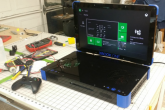Laptop and desktop buying decisions may get confusing in 2015 as Intel introduces PC chips based on two different architectures—Broadwell and Skylake—in the same year, something the chip maker rarely does.

Mainstream PCs with chips based on the Broadwell architecture—Intel’s fifth-generation Core processors—will ship in the first quarter next year. But in the second half next year, users will be able to buy PCs with processors based on the newer Skylake architecture, which will bring wire-free computing and significant performance upgrades.
Intel wants to bring the latest technology to buyers as quickly as possible, and would like to close the curtain on Broadwell’s troubled existence. Mainstream PCs with Broadwell were expected this year, but were delayed following manufacturing issues that delayed chip shipments.
Skylake chips will have the biggest PC innovations in the last 10 years, Intel believes. Skylake will bring wireless charging and data transfers, and also a “significant increase in performance, battery life and power efficiency,” said Kirk Skaugen, general manager of Intel’s PC Client Group, during last week’s Intel Developer Forum.
Intel almost swept Broadwell PC chips under the floor at IDF, except for showing a handful of PCs like a small desktop.
Consumers will continue buying laptops and desktops as and when needed, but those who care about performance and features may pass on Broadwell and wait for Skylake, analysts said. The likelihood of people waiting for Skylake PCs will increase as the year goes along.
Should you buy Broadwell?
Broadwell in PCs will have a shorter life with Skylake looming, and the feature upgrades may be a good reason for some to wait, said Jim McGregor, principal analyst at Tirias Research.
“If you’re really a technophobe, you may want to wait for Skylake,” McGregor said.
The transition to Skylake will also lead to Intel dumping Broadwell processors, which could help cut laptop prices by year end. That could benefit customers looking for low-cost laptops and prop up PC shipment volumes, McGregor said.
Desktop upgrades may be done on Skylake, which could happen first in “niche” PCs, said Dean McCarron, principal analyst at Mercury Research.
“There’s always going to be that class of users that’s waiting to buy the latest technology. If that user’s buying in May, they can wait a few months to buy a Skylake,” McCarron said.
Intel has a “tick-tock” strategy where PC chips are upgraded every year to 18 months, but manufacturing glitches delayed the release of PCs with fifth-generation Core processors. That has led to a longer life for fourth-generation Core chips based on the current Haswell architecture.
Move fast and build things
The upcoming Broadwell PC processors will consume a minimum of 15 watts of power. The processors are different from low-power chips called Core M, which are also based on Broadwell and consume as little as 4.5 watts. The Broadwell and Skylake chips are made on the 14-nanometer process.
The delay of Broadwell’s mainstream PC chips to next year raised questions on whether it would have a rollover effect on Skylake, pushing it into 2016. But Intel does not want to delay chips and give competitors a chance to gain ground, McCarron said.
“Intel learned a lesson in the Pentium 4 days, that you’re not far ahead of your competition,” McCarron said.
Intel got comfortable with Pentium 4, which got minor architectural and manufacturing upgrades from 2000 to 2008. Intel’s sluggishness helped Advanced Micro Devices—which bought innovations to its Athlon processor chips—gain PC processor market share. That woke up Intel, which then switched its architectural approach with Pentium D and subsequently Core processors, both of which succeeded.
Nonetheless, Intel will aggressively push Broadwell in laptops early next year, McCarron said.




